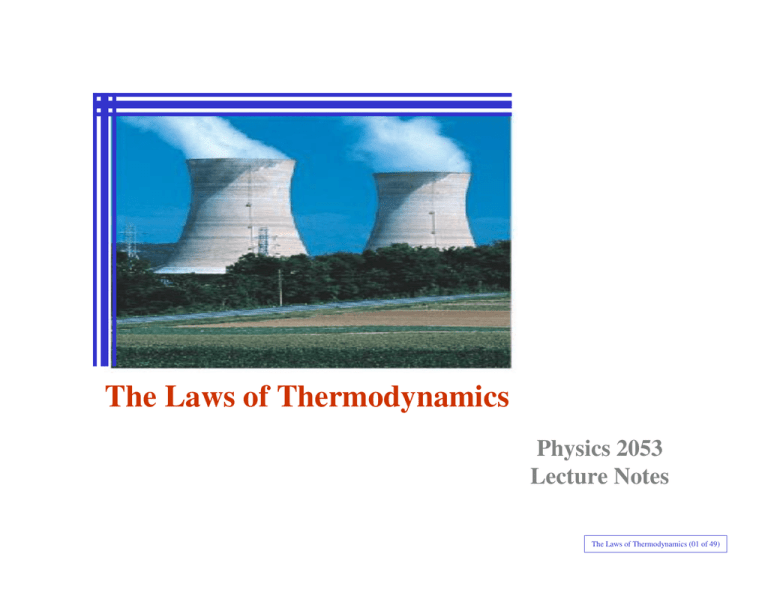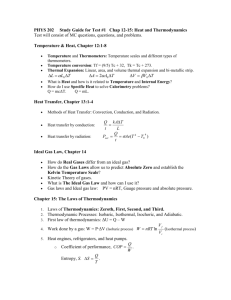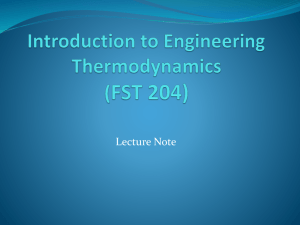The Laws of Thermodynamics Physics 2053 Lecture Notes
advertisement

The Laws of Thermodynamics Physics 2053 Lecture Notes The Laws of Thermodynamics (01 of 49) The Laws of Thermodynamics Topics 12-01 Work in Thermodynamic Processes 12-02 The First Law of Thermodynamics 12-03 Heat Engines and the Second Law of Thermodynamics 12-04 Entropy Dynamics: Newton’s Laws of Motion Work in Thermodynamic Processes F P= A F W = − F ∆x F = PA ∆V = A ∆x W= −PA ∆x W = − P ∆V Area ∆V ∆x During a compression: Work done on a gas is positive. During an expansion: Work done by a gas is negative. The Laws of Thermodynamics (04 of 49) The First Law of Thermodynamics System U Q W Environment ∆U = Q + W First Law of Thermodynamics The Laws of Thermodynamics (03 of 49) The First Law of Thermodynamics Pressure - Volume Graph Isotherms (lines of constant temperature) P Pressure T4 T3 T2 T1 Area under curve represents work Internal energy is proportional to temperature V Volume The Laws of Thermodynamics (05 of 49) The First Law of Thermodynamics Common Processes A. B. C. D. Isobaric Isochoric Isothermal Adiabatic The Laws of Thermodynamics (06 of 49) The First Law of Thermodynamics Isobaric Expansion (Constant Pressure) During an expansion: Work done by a gas is negative. P Po a) W = −Po ∆V T4 T3 T2 ∆U is positive b) ∆U increases c) Q = ∆U − W T1 ∆V V First Law of Thermodynamics: ∆U = Q + W Heat must be added The Laws of Thermodynamics (07 of 49) The First Law of Thermodynamics Isobaric Compression (Constant Pressure) During a compression: P Work done on a gas is positive. Po a) W = −Po ∆V T4 T3 T2 ∆U is Negative b) ∆U decreases c) Q = ∆U − W T1 ∆V V First Law of Thermodynamics: ∆U = Q + W Heat must be removed The Laws of Thermodynamics (08 of 49) The Laws of Thermodynamics 12-01 The process shown on the Pressure-Volume diagram is an A. adiabatic expansion. B. isothermal expansion. C. isometric expansion. D. isobaric expansion. P o V The First Law of Thermodynamics Isochoric (Constant Volume) Decrease in Pressure P a) W = 0 Po ∆U is Negative b) ∆U decreases c) Q = ∆U Pf T3 T2 T1 V First Law of Thermodynamics: ∆U = Q + W Heat must be removed The Laws of Thermodynamics (10 of 49) The First Law of Thermodynamics Isochoric (Constant Volume) Increase in Pressure P a) W = 0 Pf ∆U is positive b) ∆U increases c) Q = ∆U Po T3 T2 T1 V First Law of Thermodynamics: ∆U = Q + W Heat must be added The Laws of Thermodynamics (11 of 49) The Laws of Thermodynamics 12-01 The process shown on the PV diagram is A. adiabatic. B. isothermal. C. isochoric. D. isobaric. P o V The Laws of Thermodynamics 12-01 In an isochoric process, there is no change in A. pressure. B. temperature. C. volume. D. internal energy. The First Law of Thermodynamics Isothermal (Constant Temperature) Expansion During an expansion: P Work done by a gas is negative. a) W is negative Po b) ∆U = 0 T3 T2 Pf T1 Vo Vf c) Q = −W Heat must be added V First Law of Thermodynamics: ∆U = Q + W The Laws of Thermodynamics (14 of 49) The First Law of Thermodynamics Isothermal (Constant Temperature) Compression During a compression: P Work done on a gas is positive. a) W is positive Pf b) ∆U = 0 Po T3 T2 T1 V Vo Vf First Law of Thermodynamics: ∆U = Q + W c) Q = −W Heat must be removed The Laws of Thermodynamics (15 of 49) The Laws of Thermodynamics 12-01 The process shown on the Temperature-Volume graph is an A. adiabatic compression. B. isothermal compression. C. isochoric compression. D. isobaric compression. T o V The Laws of Thermodynamics 12-01 When the first law of thermodynamics, ∆U = Q + W, is applied to an ideal gas that is taken through an isothermal process, A. ∆U = 0 B. W=0 C. Q=0 D. none of the above The Laws of Thermodynamics 12-01 An ideal gas is compressed to one-half its original volume during an isothermal process. The final pressure of the gas A. increases to twice its original value. B. increases to less than twice its original value. C. increases to more than twice its original value. D. does not change. The First Law of Thermodynamics Adiabatic (No Heat Exchange) Expansion During an expansion: P Work done by a gas is negative. a) W = Negative Po ∆U is Negative b) ∆U decreases T2 Pf T1 V Vo Vf First Law of Thermodynamics: ∆U = Q + W c) Q = 0 W = ∆U Negative work done by the gas is equal to the decrease in internal energy. The Laws of Thermodynamics (19 of 49) The First Law of Thermodynamics Adiabatic (No Heat Exchange) Compression During a compression: P Work done on a gas is positive. a) W = Positive Pf ∆U is positive b) ∆U increases T2 Po T1 V Vf Vo First Law of Thermodynamics: ∆U = Q + W c) Q = 0 W = ∆U Positive work done on the gas is equal to the increase in internal energy. The Laws of Thermodynamics (20 of 49) The Laws of Thermodynamics 12-01 When the first law of thermodynamics, ∆U = Q + W, is applied to an ideal gas that is taken through an adiabatic process, A. ∆U = 0. B. W = 0. C. Q = 0. D. none of the above The First Law of Thermodynamics (Problem) An ideal gas expands to 10 times its original volume, maintaining a constant 440 K temperature. If the gas does 3.3 kJ of work on its surroundings, how much heat does it absorb? First Law of Thermodynamics: P Isothermal process: ∆U = 0 Po W = −3000 J ∆U = Q + W Q = ∆U − W Q = 0 − (− 3000 J ) Q = 3000 J Pf T Vo Vf V The Laws of Thermodynamics (22 of 49) The Laws of Thermodynamics 12-01 A gas is taken through the cycle illustrated here. During one cycle, how much work is done by an engine operating on this cycle? A. PV 2P B. 2PV P C. 3PV D. 4PV V 2V 3V 4V The First Law of Thermodynamics (Problem) II An ideal gas initially has pressure Po, at volume Vo and absolute temperature To. It then undergoes the following series of processes: 2Po III I Po IV Vo 2Vo 3Vo I. Heated, at constant volume to pressure 2Po II. Heated, at constant pressure to pressure 3Vo III. Cooled, at constant volume to pressure Po IV. Cooled, at constant pressure to volume Vo The Laws of Thermodynamics (24 of 49) The First Law of Thermodynamics (Problem) con’t 2Po 2To II • • 6To III • • I Po To Vo IV 2Vo 3To 3Vo Find the temperature at each end point in terms of To The Laws of Thermodynamics (25 of 49) The First Law of Thermodynamics (Problem) con’t II • 2Po • III I Find the net work done by the gas in terms of Po and Vo Po • • IV Vo 2Vo 3Vo The Laws of Thermodynamics (26 of 49) The First Law of Thermodynamics (Problem) con’t II • 2Po • III I Find the net change in internal energy in terms of Po and Vo Po • • IV Vo 2Vo 3Vo The Laws of Thermodynamics (27 of 49) Heat Engines and the Second Law of Thermodynamics The second law of thermodynamics is a statement about which processes occur and which do not. There are many ways to state the second law; here is one: Heat will flow spontaneously from a hot object to a cold object. It will not flow spontaneously from a cold object to a hot object. The Laws of Thermodynamics (28 of 49) Heat Engines and the Second Law of Thermodynamics Direction of Time The Laws of Thermodynamics (29 of 49) Heat Engines and the Second Law of Thermodynamics In a heat engine; mechanical energy can be obtained from thermal energy when heat flows from a higher temperature to a lower temperature. Work done by engine: High Temp. Th W = Qh − Qc Thermal efficiency: Qh Engine Qc Low Temp. Tc W e= e= W Qh Qh − Qc Qh Qc e = 1− Qh The Laws of Thermodynamics (30 of 49) Heat Engines and the Second Law of Thermodynamics Th= 550 K For the engine = 920 J Qh Work done by engine each cycle W = Qh − Qc Engine Qc W = 920 J − 630 J = 290 J W = 630 J Tc The efficiency of the engine e= W 290 J = 0.315 = Qh 920 J ⇒ 31.5 % The Laws of Thermodynamics (31 of 49) Heat Engines and the Second Law of Thermodynamics The Carnot Cycle P Isothermal Expansion Th Adiabatic Compression Adiabatic Expansion Tc V Isothermal Compression The Laws of Thermodynamics (32 of 49) Heat Engines and the Second Law of Thermodynamics P High Temp. Th Qh Qh Engine W Th Work Qc Low Temp. Tc Carnot efficiency: Tc e = 1− Th Tc Qc Tc ⇒ = Qh Th Qc V The Laws of Thermodynamics (33 of 49) Heat Engines and the Second Law of Thermodynamics Th= 550 K For the engine = 890 J Qh Work done by engine each cycle Engine W W = Qh − Qc Qc W = 890 J − 470 J = 420 J = 470 J Tc The efficiency of the engine e= W 420 J = 0.472 = Qh 890 J ⇒ 47.2 % The Laws of Thermodynamics (34 of 49) Heat Engines and the Second Law of Thermodynamics Th= 550 K Temperature of the cool reservoir Qc Tc = Qh Th Qc ⇒ Tc = Th Qh 470 J Tc = 550 K 550 J = 890 J Qh Engine Qc = 290 K W = 420 J = 470 J Tc The engine undergoes 22 cycles per second, its mechanical power output J cycles W 22 = Wf = 420 P= cycle s t = 9.24 kW The Laws of Thermodynamics (35 of 49) Heat Engines and the Second Law of Thermodynamics (Problem) Th A carnot engine absorbs 900 J of heat each cycle and provides 350 J of work Qh = 900 J Engine W = 350 J Qc Tc The Laws of Thermodynamics (36 of 49) Heat Engines and the Second Law of Thermodynamics (Problem) Th A carnot engine absorbs 900 J of heat each cycle and provides 350 J of work Qh = 900 J Engine Qc W = 350 J =550 J Tc = 283 K The Laws of Thermodynamics (37 of 49) Heat Engines and the Second Law of Thermodynamics (Problem) Th= 650 K A carnot engine operates between a hot reservoir at 650 K and a cold reservoir at 300 K. If it absorbs 400 J of heat at the hot reservoir, how much work does it deliver? Qh = 400 J Engine W=? Qc Tc= 300 K The Laws of Thermodynamics (38 of 49) The Laws of Thermodynamics 12-01 If the theoretical efficiency of a Carnot engine is to be 100%, the heat sink must be A. at absolute zero. B. at 0°C. C. at 100°C. D. infinitely hot. The Laws of Thermodynamics 12-01 A Carnot cycle consists of A. two adiabats and two isobars. B. two isobars and two isotherms. C. two isotherms and two isomets. D. two adiabats and two isotherms. Entropy The Laws of Thermodynamics (41 of 49) Entropy Definition of the change in entropy S when an amount of heat Q is added: Q ∆S = T Another statement of the second law of thermodynamics: The total entropy of an isolated system never decreases. When an irreversible process occurs in a closed system, the entropy S of the system always increases: it never decreases. The Laws of Thermodynamics (42 of 49) Entropy Entropy is a measure of the disorder of a system. This gives us yet another statement of the second law: Natural processes tend to move toward a state of greater disorder. Example: If you put milk and sugar in your coffee and stir it, you wind up with coffee that is uniformly milky and sweet. No amount of stirring will get the milk and sugar to come back out of solution. The Laws of Thermodynamics (43 of 49) Entropy Another example: when a tornado hits a building, there is major damage. You never see a tornado approach a pile of rubble and leave a building behind when it passes. Thermal equilibrium is a similar process – the uniform final state has more disorder than the separate temperatures in the initial state. The Laws of Thermodynamics (44 of 49) Entropy Another consequence of the second law: In any natural process, some energy becomes unavailable to do useful work. If we look at the universe as a whole, it seems inevitable that, as more and more energy is converted to unavailable forms, the ability to do work anywhere will gradually vanish. This is called the heat death of the universe. The Laws of Thermodynamics (45 of 49) The Laws of Thermodynamics 12-01 The second law of thermodynamics leads us to conclude that A. the total energy of the universe is constant. B. disorder in the universe is increasing with the passage of time. C. it is theoretically possible to convert heat into work with 100% efficiency. D. the average temperature of the universe is increasing with the passage of time. The Law of Thermodynamics Summary First law of thermodynamics: ∆U = Q + W Isothermal process: temperature is constant. Adiabatic process: no heat is exchanged. Work done by gas at constant pressure: W = − P∆V Heat engine changes heat into useful work (requires temperature difference). Efficiency of a heat engine: Carnot efficiency: W QL e= = 1− QH QH TL ec = 1 − TH The Laws of Thermodynamics (47 of 49) The Law of Thermodynamics Summary Second law of thermodynamics: heat flows spontaneously from a hot object to a cold one, but not the reverse Thermal energy cannot be changed entirely to work natural processes tend to increase entropy. Change in entropy: ∆S = Q T Entropy is a measure of disorder. As time goes on, less and less energy is available to do useful work. The Laws of Thermodynamics (48 of 49) The Laws of Thermodynamics (49 of 49)





